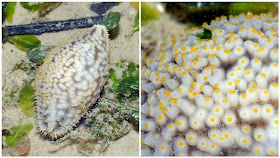Ron and I had a great trip at Changi shore with lots of seahorse sightings during early November this year!
Here's a pair of seahorse that was spotted on this trip. Yes, seahorses can be found on our Singapore shores during low tide on seagrass beds and reefy areas.
In fact, it was a bounty surprise that we found a total of seven seahorses on a single trip! These yellow seahorses are also known as Estuarine seahorses (Hippocampus kuda).
The tiny white and black spots on its yellow body are very pretty. Do take a closer look at a seahorse if you were to spot a live one.
Also, do not forget to log your observation at the iSeahorse website which serves as a citizen science tool that harnesses the power of anyone in the world who sees a seahorse in the wild. This allows the team to improve our understanding of these animals and protect them from overfishing and other threats. You may read more about their works on Mei Lin's blog post.
A close cousin to the seahorse would be the Seagrass pipefish. They both belong to Family Syngnathidae.
'Syngnathus' means 'fused jaws' in Greek. Seahorses and pipefishes feed
on tiny creatures by sucking them up with their tube-like, toothless
snouts. In addition, both of their eggs are looked after by the papas (males) instead.
Changi shore is a rich haven of echinoderms where one can find lots of sea stars, sea cucumbers and more! Here's a huge Biscuit sea star (Goniodiscaster scaber) with a Thorny sea cucumber (Colochirus quadrangularis).
More sea stars comprising of Biscuit sea stars (Goniodiscaster scaber) and Cake sea stars (Anthenea aspera)!
We also saw this lone Eight-armed sand star (Luidia maculata) which is actually a six-armed version. This six-armed variant has been very commonly sighted recently and we have no idea why.
Talking about being clueless, there are several sea cucumbers that we see in the north that we do not know of their identity such as this Beige sea cucumber.
Another unknown sea cucumber would be this Smooth sea cucumber.
One of the more intriguing unidentified sea cucumbers would definitely be this one with bumps and yellow dots.
Though the Thorny sea urchins (Prionocidaris sp.) are not common on many of our northern shores, we do find them in abundance at Beting Bronok, north of Tekong. Glad to spot one small version on this trip.
This beautiful and graceful looking flatworm is known as the Brown striped flatworm (Pseudobiceros gratus).
Well camouflaged among the seagrasses and seaweed, this tiny Seagrass filefish (Acreichthys tomentosus) is not easy to spot unless you notice their movement.
Another well camouflaged critter would be this "moving sponge". Haha! It is actually a crab using a sponge as a form of disguise. This crab is known as the Sponge crab (Family Dromiidae).
On the high shore, I spotted this dead crab or crab moult that looks unfamiliar. Anyone can help with its id?
The rocky area is also home to yet another range of marine organisms, one of which would be the commonly found Thunder crab (Myomenippe hardwickii).
This wriggly snake-like creature is actually a Estuarine moray (Gymnothorax tile) and it crept out when we check out the rocks.
What's a rocky shore without the Rock stars (Asterina coronata)? Haha! Also known as Crown sea stars, the rock stars come in different colours though the brighter ones are less common.
More photos of the trip can be viewed here: http://www.flickr.com/photos/koksheng/archives/date-taken/2013/11/06/


















No comments:
Post a Comment